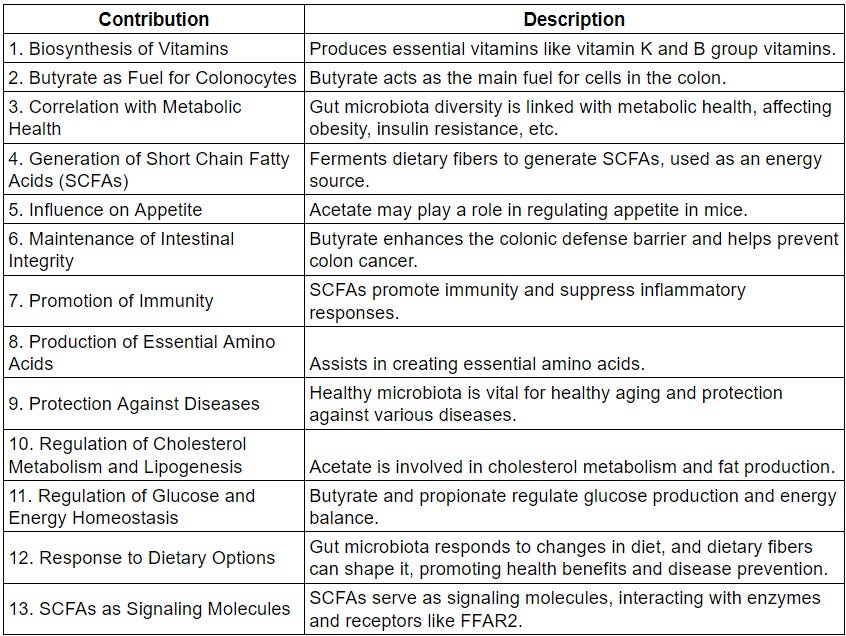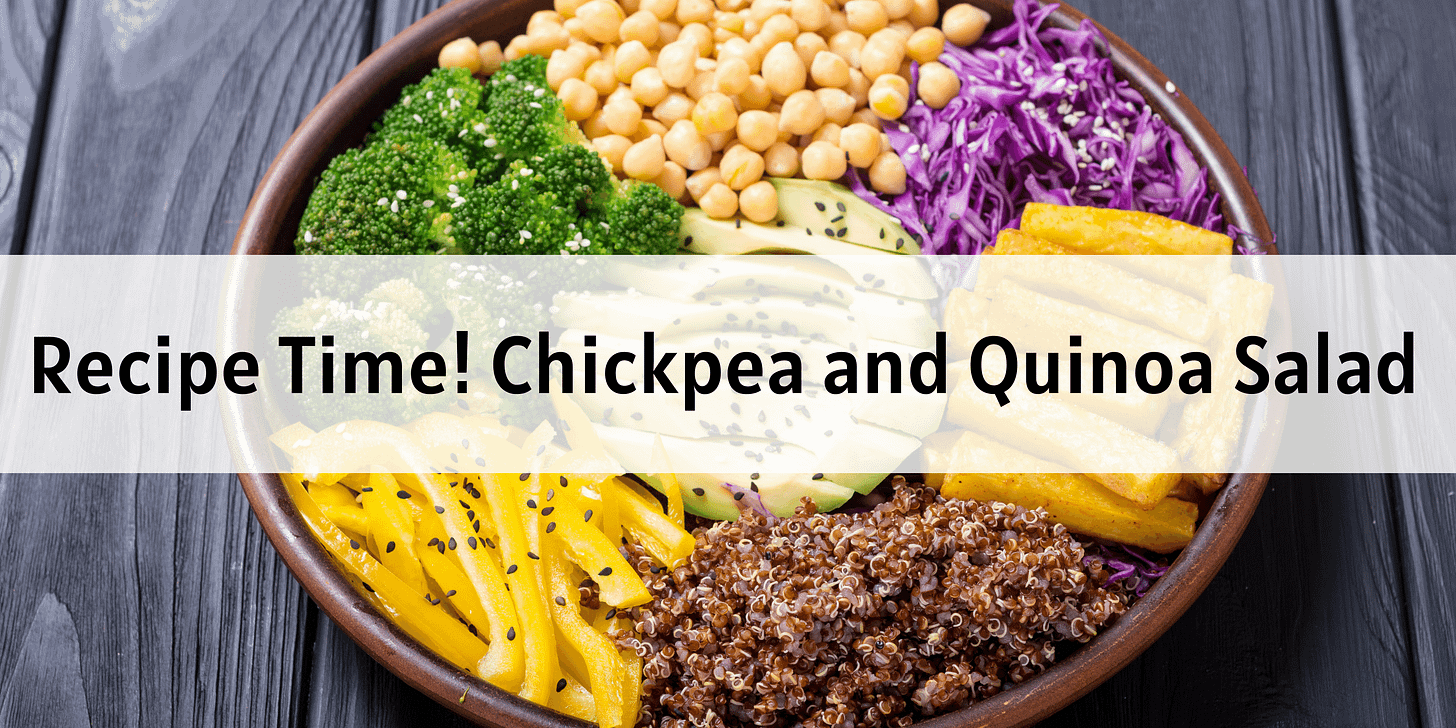Lunchtime Read: The Fiber Factor - How What You Eat Shapes Your Gut and Your Health
The healthy bacteria in your gut also contributes to longevity.
Did you know that the food you eat doesn't just fill your stomach? It also feeds trillions of tiny organisms living inside your gut. These little creatures, known as gut microbiota, play a huge role in keeping you healthy. Let's dive into the world of gut microbiota and discover how dietary fibers can help you grow old healthily!
What's Living in Your Gut?
Your gut is home to about 100 trillion microorganisms, including bacteria, viruses, fungi, and protozoa. Most of them are friendly and help you in many ways. Here's how:
Making Vitamins: They produce vitamins like vitamin K and some B vitamins.
Creating Energy: They turn fibers from your food into short chain fatty acids (SCFAs), which your body uses for energy.
Boosting Immunity: SCFAs help your immune system and keep inflammation in check.
Protecting Your Gut: Some SCFAs, like butyrate, help keep the lining of your gut healthy.
The Power of Dietary Fibers
Dietary fibers are parts of plants that your body can't digest. They travel to your large intestine, where your gut microbiota feast on them. When they eat these fibers, they produce SCFAs. Some well-known dietary fibers are inulin, fructooligosaccharides (FOS), and galactooligosaccharides (GOS), found in grains, fruits, and vegetables.
Why Fibers Are Important
Diversity in Gut: Eating fibers helps increase the variety and number of good bacteria in your gut.
Disease Prevention: A diet rich in fibers can reduce the risk of heart disease, type 2 diabetes, and even some cancers.
Weight Control: Fibers help in controlling weight by regulating how your body uses sugar and fat.
Fighting Bad Diets: Diets low in fiber and high in fat can harm your gut. Fibers can help protect against this damage.
How Much Fiber Do You Need?
Different countries have different recommendations for fiber intake. In the UK, adults are advised to consume at least 30 grams per day, while in the US, the recommendation is around 25 grams for females and 35 grams for males. Sadly, most people around the world eat less fiber than they should.
The Recommended Daily Fiber Intake Varies in Each Region
1. Optimal Intake Globally: Estimated to be 24 grams per day.
2. United Kingdom: Recommended intake for adults is at least 30 grams per day. The average intake was estimated to be 14.9 grams per day (as of 2016/17 data).
3. United States: Recommended intake is around 25 grams per day for adult females and around 35 grams per day for adult males.
4. Asia: Lowest intake regionally, around 8-10 grams per day.
5. Oceania and Western and Eastern Sub-Saharan Africa: Highest intake regionally, around 16-20 grams per day.
However, the average intake of fibers is consistently lower than the recommended 24 grams per day in all regions around the world.
How to Add More Fiber to Your Diet
Eating more whole grains, vegetables, and fruits is a great way to boost your fiber intake. Here are some ideas:
Choose whole-grain bread and cereal for breakfast.
Snack on fruits and nuts.
Add vegetables to your meals.
Conclusion
Your gut is like a bustling city of microorganisms, and dietary fibers are their favorite food. By eating a fiber-rich diet, you're not just feeding yourself; you're nourishing your gut's tiny inhabitants. This helps them thrive and, in turn, keeps you healthy.
So next time you're at the grocery store, remember to pick up some whole grains, fruits, and vegetables. Your gut will thank you, and you'll be taking a big step towards healthy aging!
Servings: 4
Ingredients:
- 1 cup quinoa, rinsed
- 1 can (15 oz) chickpeas, drained and rinsed
- 1 cucumber, diced
- 1 bell pepper, diced
- 1 avocado, diced
- 1/4 cup fresh parsley, chopped
- 2 tablespoons olive oil
- Juice of 1 lemon
- Salt and pepper to taste
- Optional: 2 tablespoons flaxseed for added fiber
Instructions:
1. Cook Quinoa: In a medium pot, bring 2 cups of water to a boil. Add the quinoa, reduce heat to low, cover, and simmer for 15 minutes or until quinoa is cooked and water is absorbed. Fluff with a fork and let cool.
2. Prepare Vegetables: While the quinoa is cooking, chop the cucumber, red bell pepper, avocado, and parsley.
3. Make Dressing: In a small bowl, whisk together the olive oil, lemon juice, salt, and pepper.
4. Combine Ingredients: In a large bowl, combine the cooked quinoa, chickpeas, chopped vegetables, and dressing. Toss well to coat.
5. Add Flaxseed: If using, sprinkle in the flaxseed and stir well to combine.
6. Chill or Serve Immediately: You can serve the salad immediately or chill it in the refrigerator for about 30 minutes to let the flavors meld.
7. Garnish and Serve: Garnish with additional parsley if desired, and serve as a main or side dish.
Nutritional Benefits:
- Quinoa: A complete protein and a great source of dietary fiber.
- Chickpeas: High in fiber and protein, aiding in digestion.
- Vegetables: Provide vitamins, minerals, and additional fiber.
- Flaxseed: Optional, but an excellent source of omega-3 fatty acids and extra fiber.
This Chickpea and Quinoa Salad is not only quick and easy to make but also packed with ingredients that nourish your gut microbiota. It's a refreshing and satisfying meal that can be enjoyed on its own or paired with grilled chicken or fish for added protein. Enjoy!




